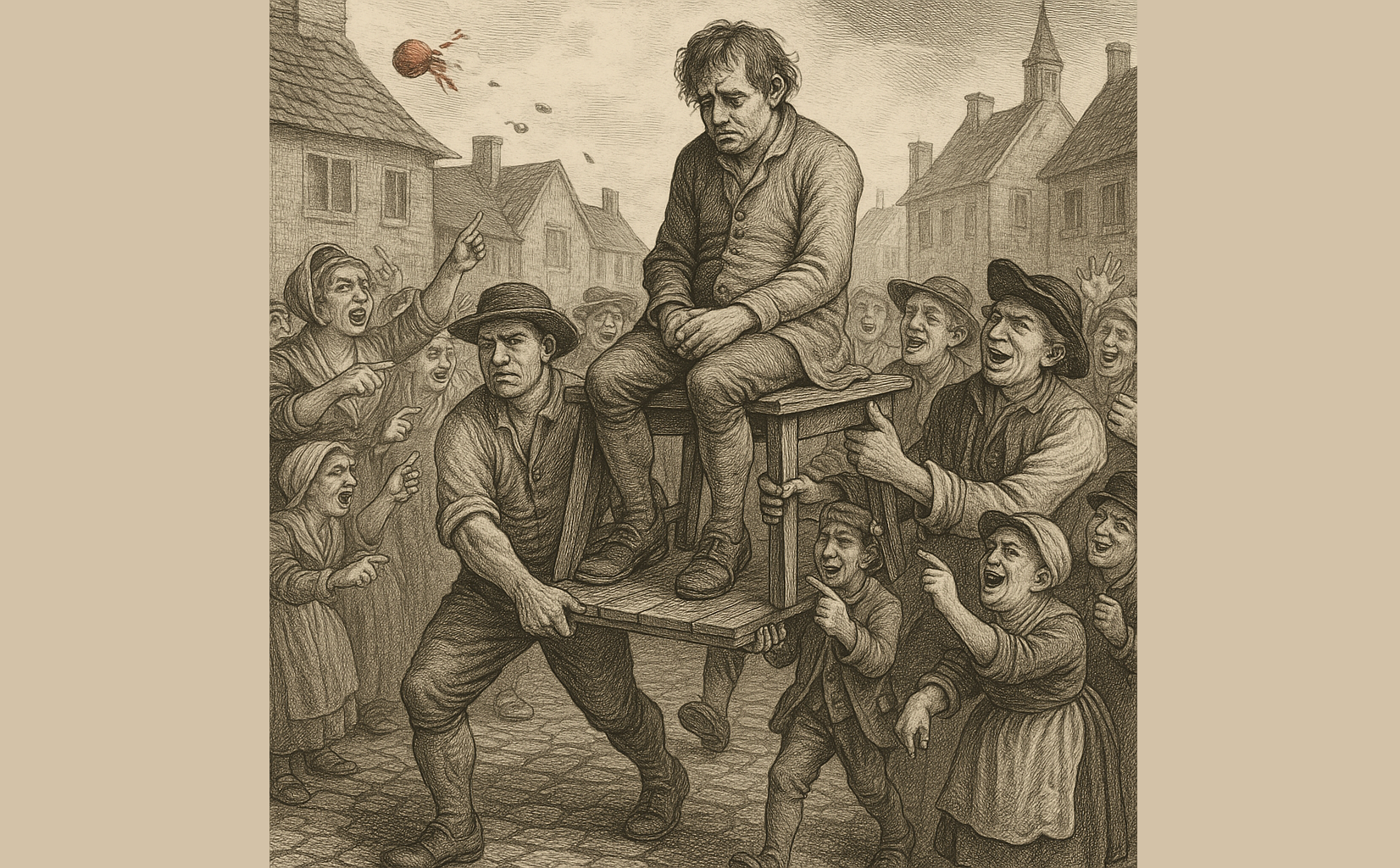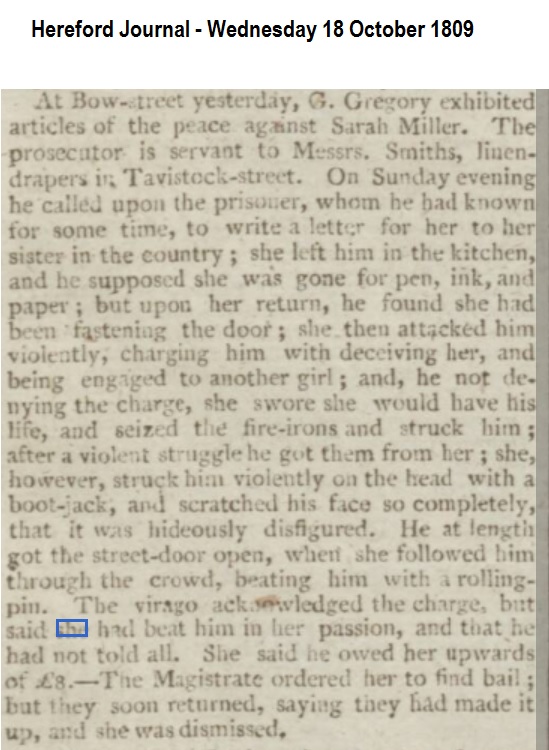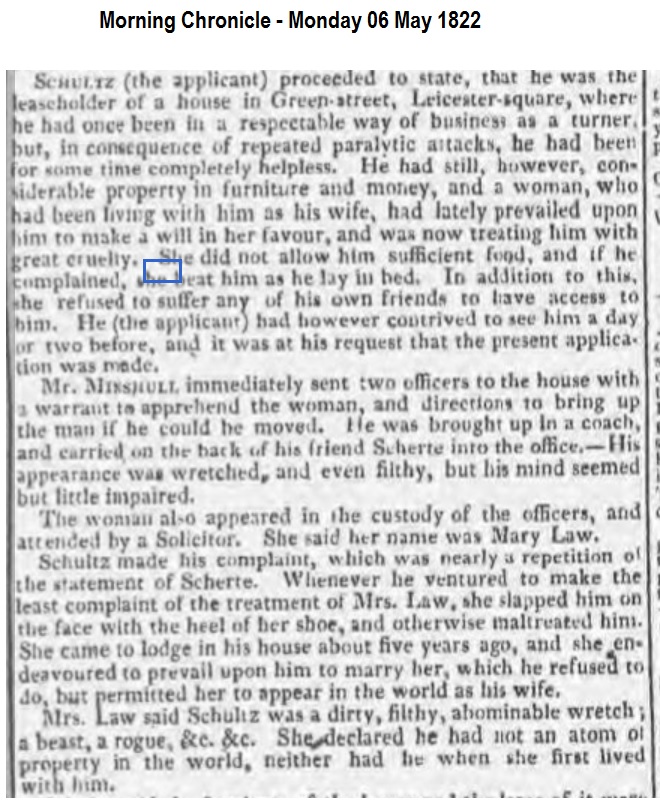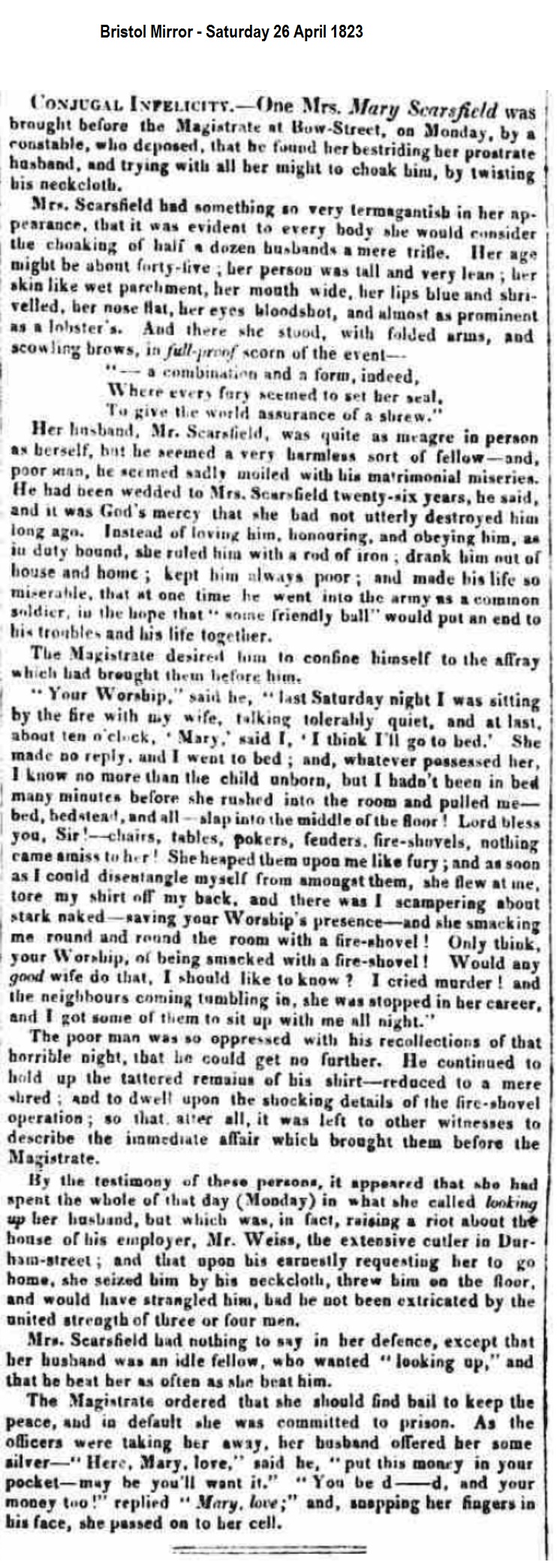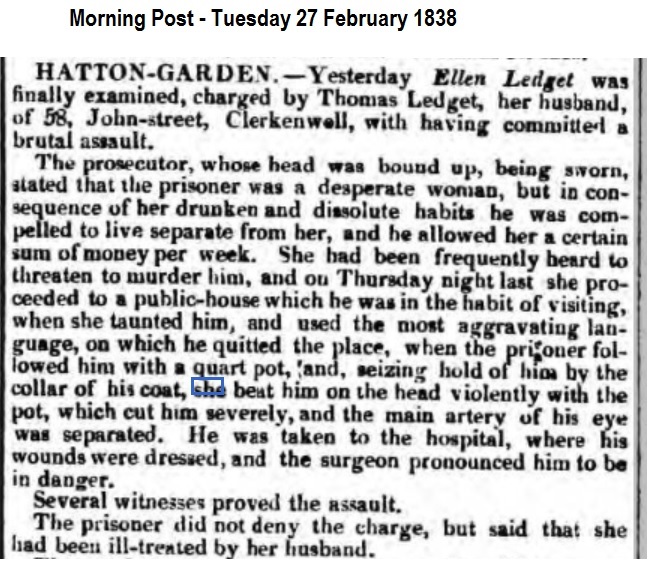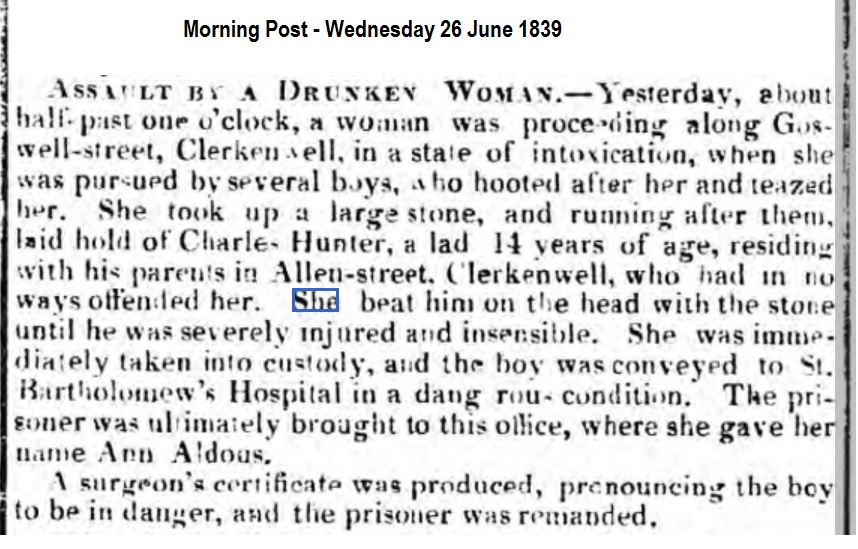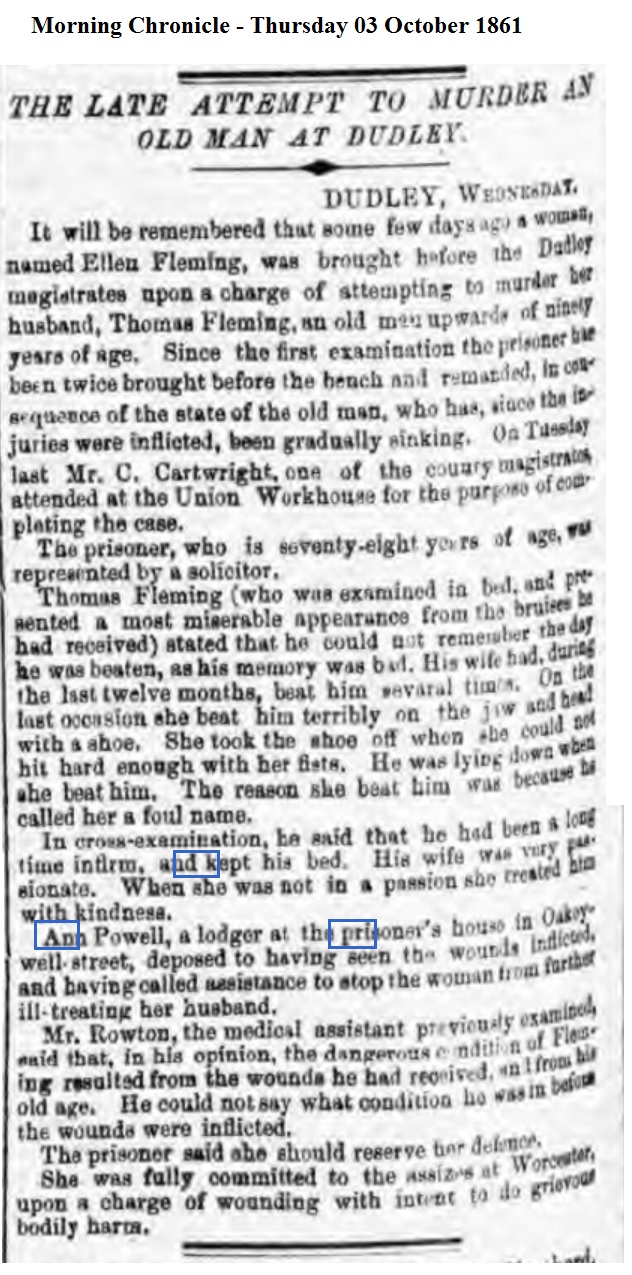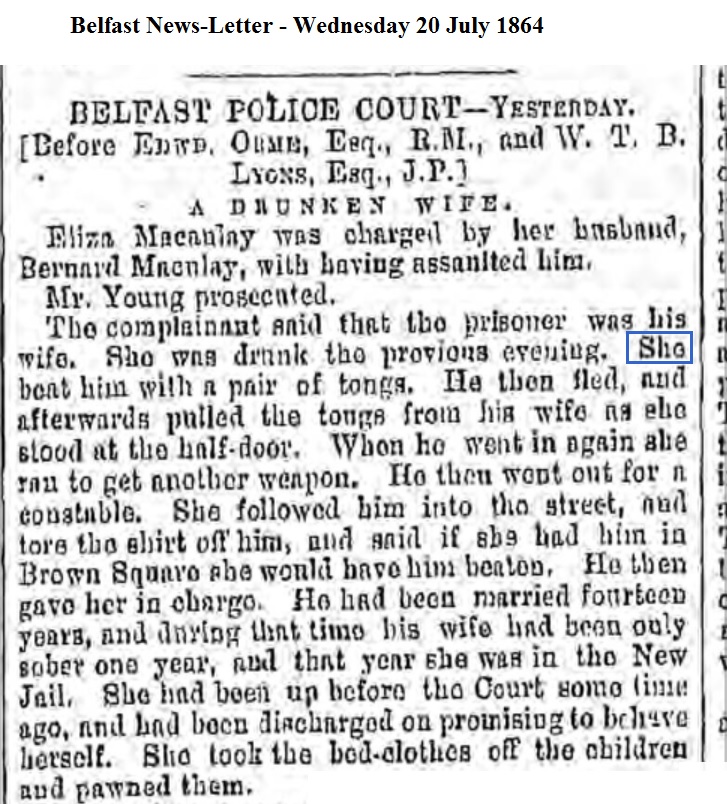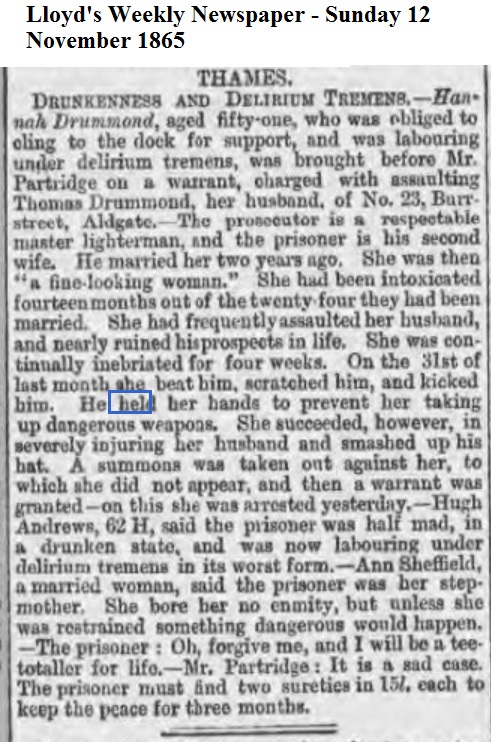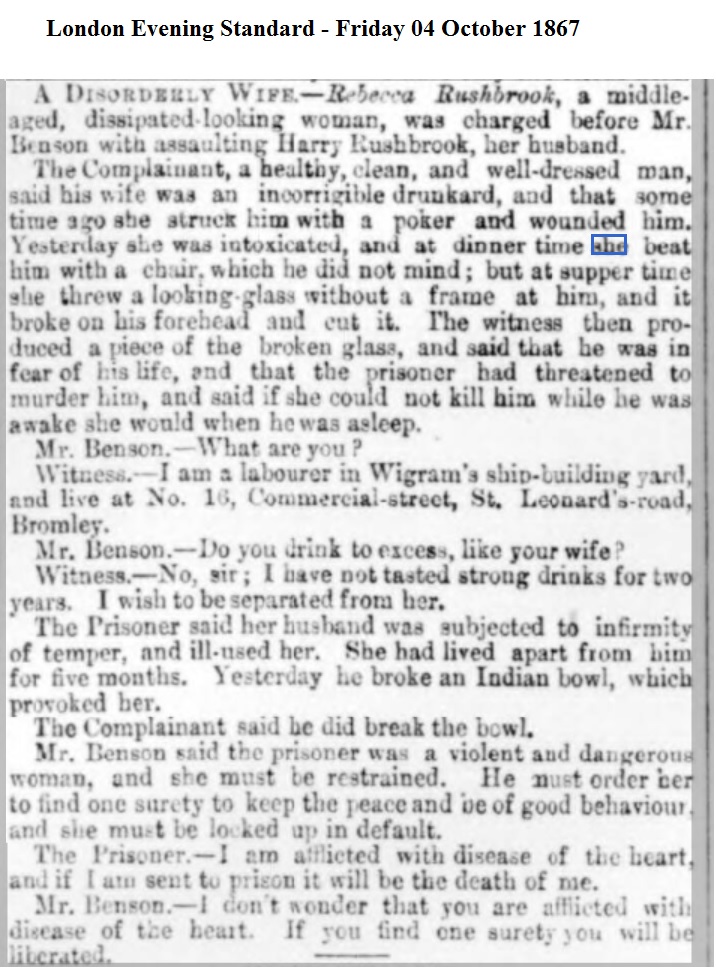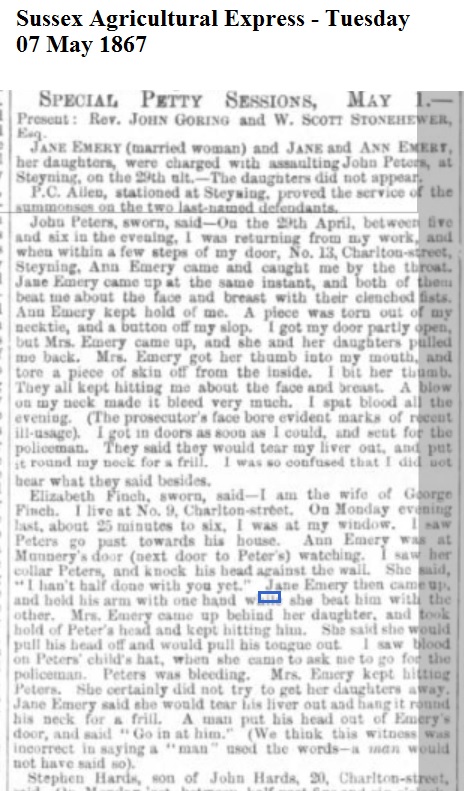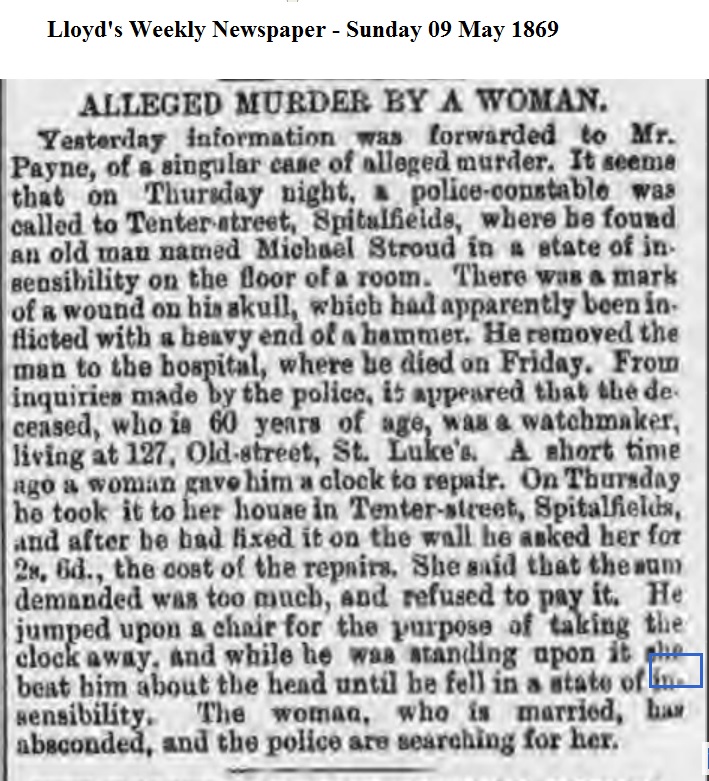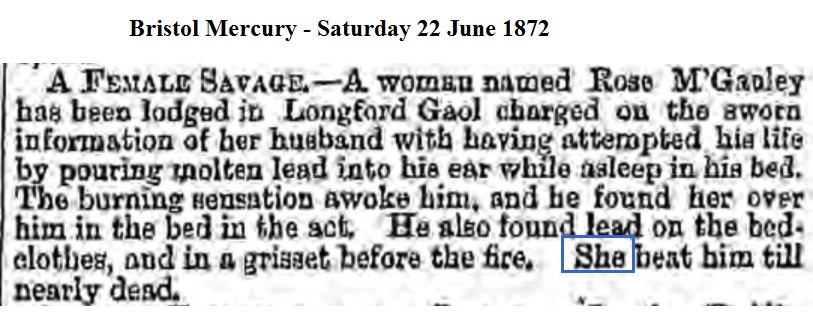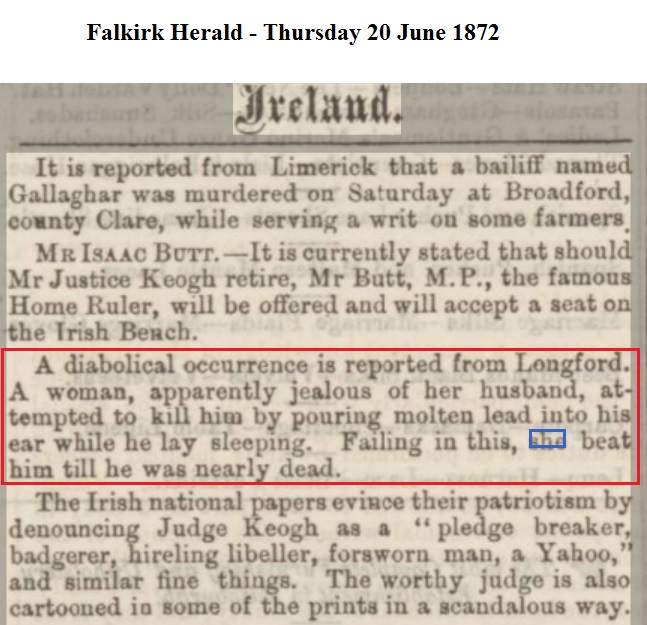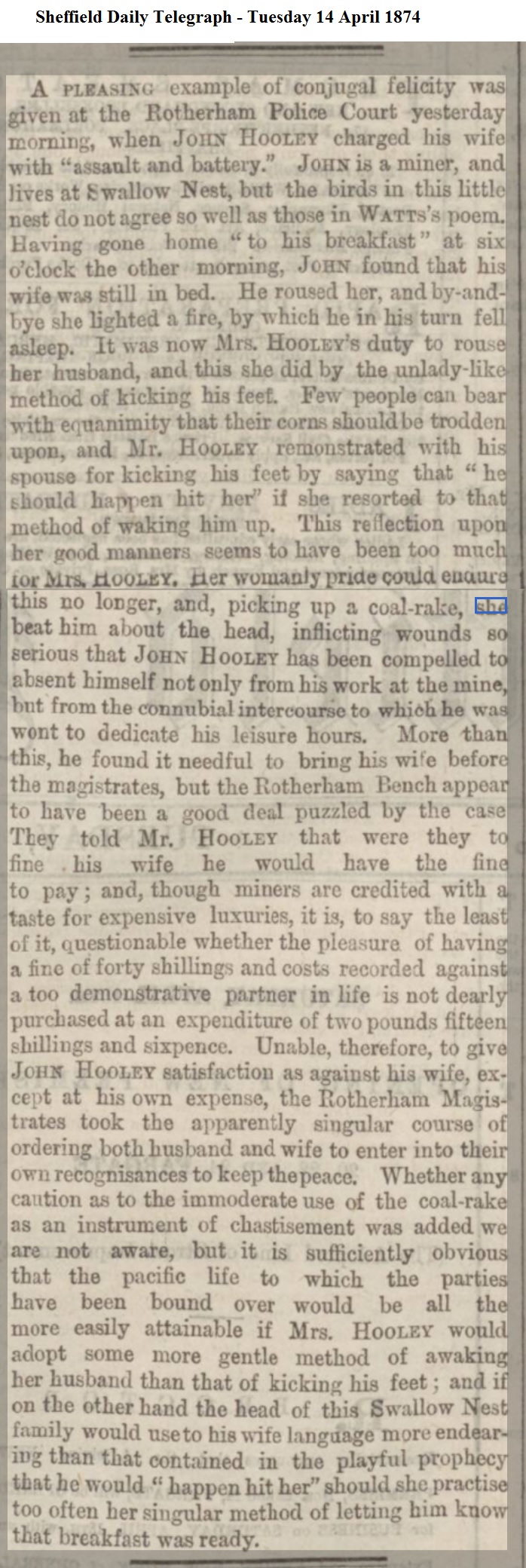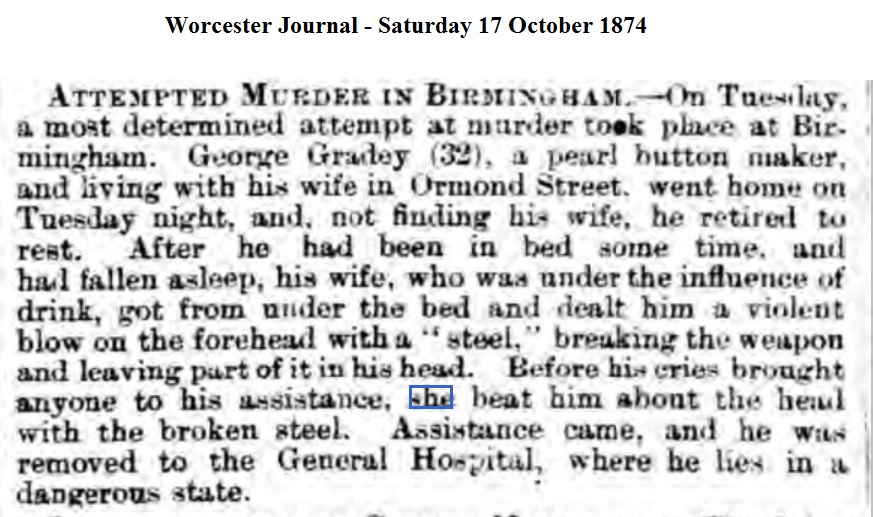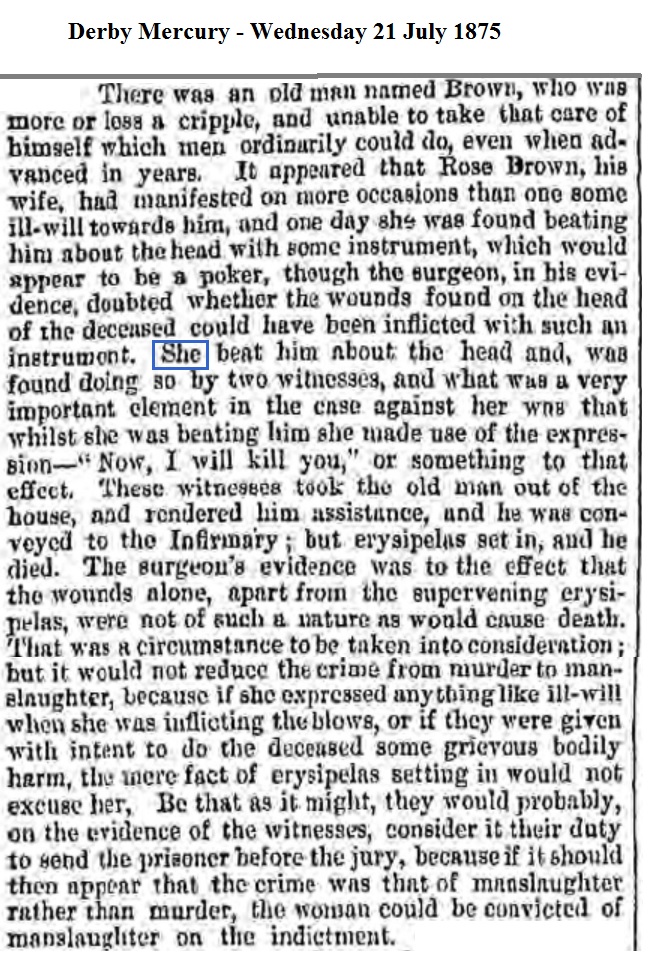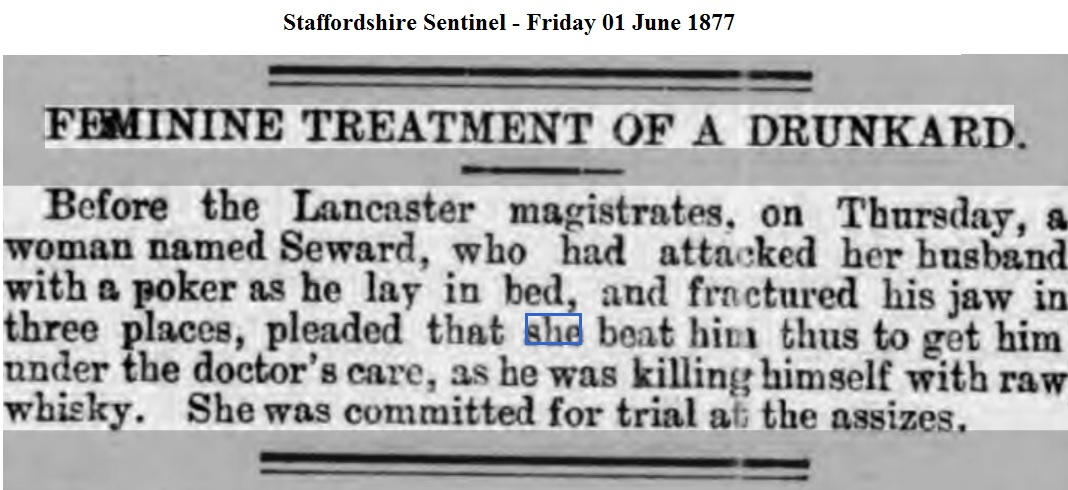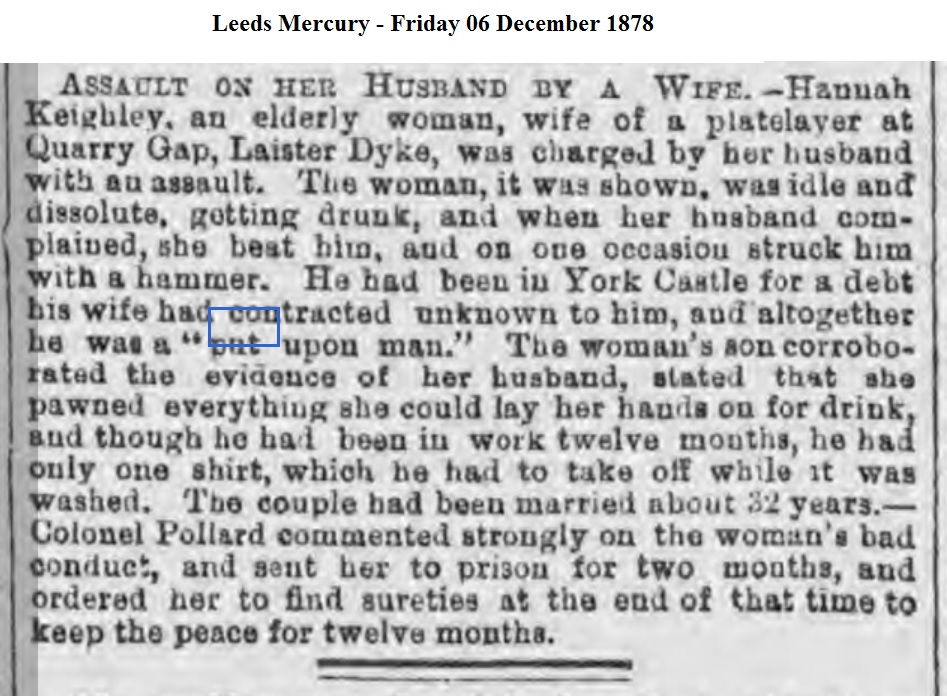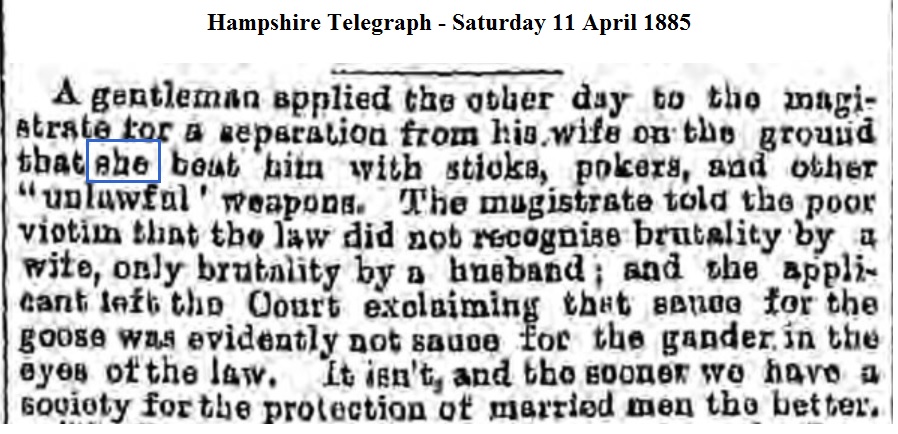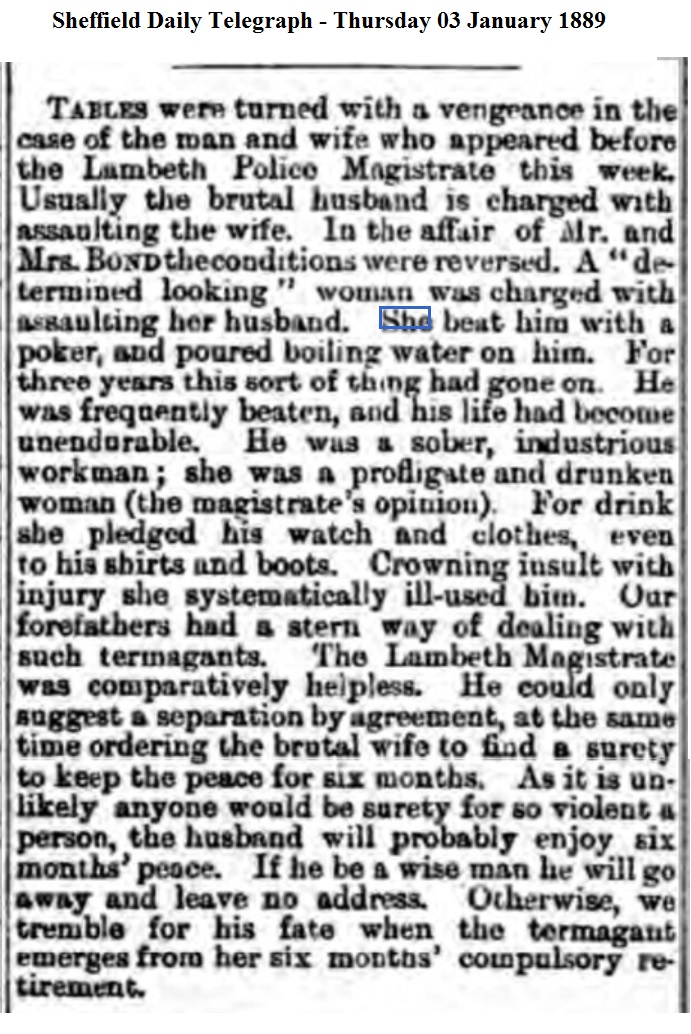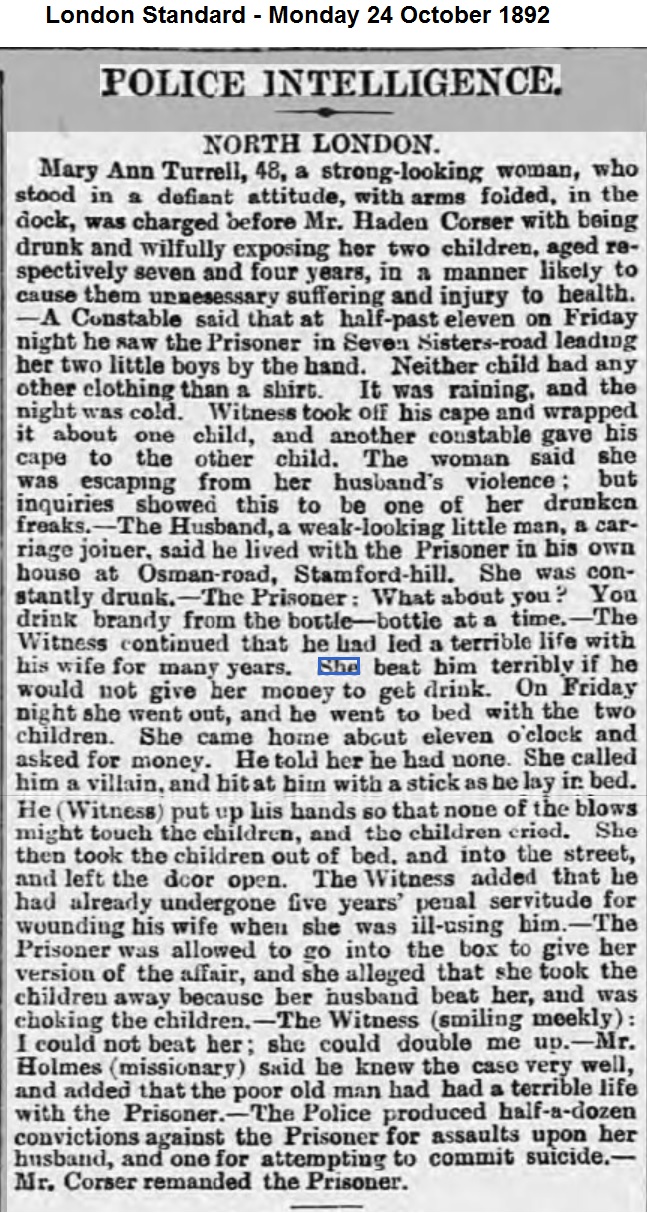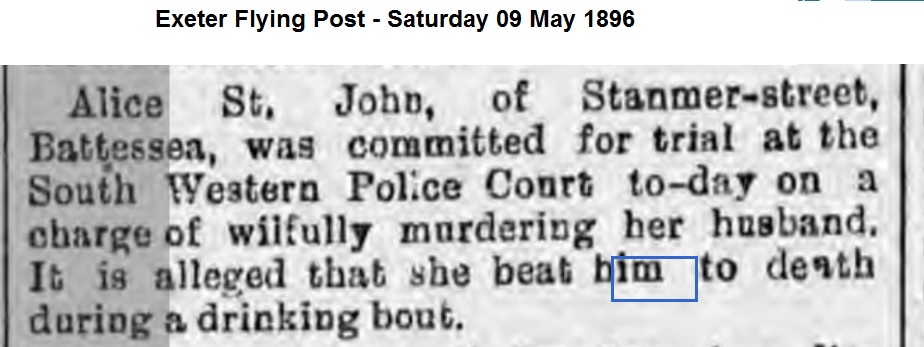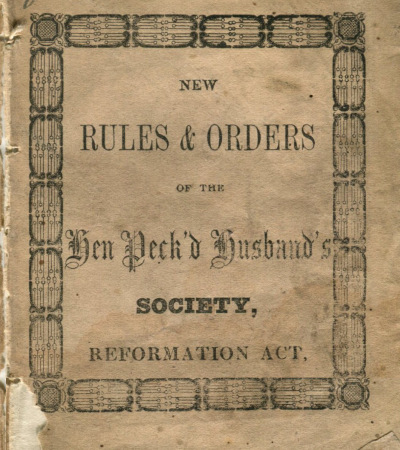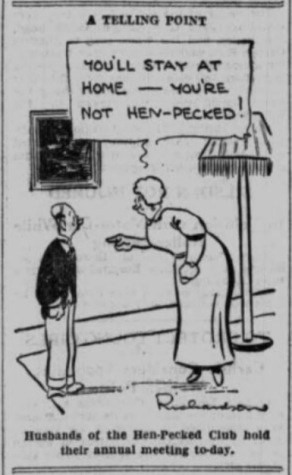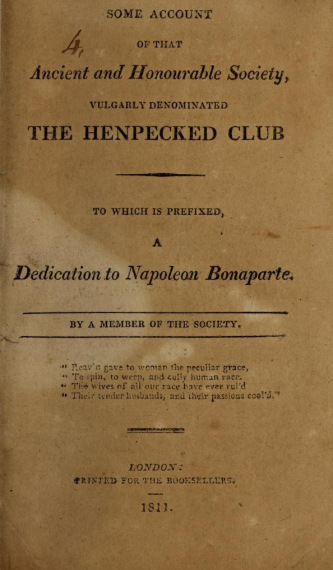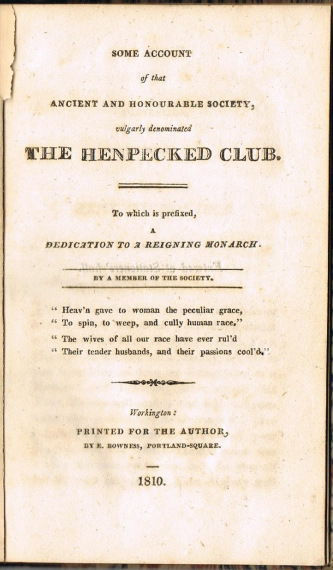By Malcolm J. George
In post-Renaissance France and England, society ridiculed and humiliated husbands thought to be battered and/or dominated by their wives (Steinmetz, 1977-78). In France, for instance, a “battered” husband was trotted around town riding a donkey backwards while holding its tail. In England, “abused” husbands were strapped to a cart and paraded around town, all the while subjected to the people’s derision and contempt. Such “treatments” for these husbands arose out of the patriarchal ethos where a husband was expected to dominate his wife, making her, if the occasion arose, the proper target for necessary marital chastisement; not the other way around (Dobash & Dobash, 1979).
Although the patriarchal view supporting a husband’s complete dominance of his wife persisted into the twentieth century (E. Pleck, 1987), during the latter half of this century, we find a definite shift in people’s attitudes toward marital relationships. Beginning in the 1970s, for instance, advocates like Del Martin (1976) and Erin Pizzey (Pizzey 1974; Pizzey & Shapiro, 1982) exposed the “hidden” secret of domestic violence. As a result, terms like “domestic violence,” “domestic abuse,” and “battered wife” have found their way into our everyday speech. Finally, society seems to be taking the issue of domestic violence against women seriously and looking for solutions to stem if not to end the violence.
Most of the early research dealing with domestic violence focused solely on the female victims and the social factors that supported the victimization of women (Smith, 1989). Consequently, a voluminous literature now exists that portrays domestic violence as a unitary social phenomenon stemming from a patriarchal social order where women are portrayed as the victims and men perceived as the perpetrators (Dobash & Dobash, 1979). Such research has had a significant impact upon the evolution of recent changes in civil law, enforcement of criminal law, and the ways law enforcement and social agencies respond to the needs of battered wives (see Victim Support, 1992).
As noted in the opening section, finding evidence that society in centuries past found it necessary to punish men who did not uphold the patriarchal way suggests previous recognition that a husband could be assaulted or dominated by his wife. In recent years though, such a possibility has found little support or credence. Rather, the view of husband-as-victim of domestic violence is more likely a subject of cartoons (Saenger, 1963) or of jokes about “hen-pecked” husbands (Wilkinson, 1981). In fact, raising the issue of husband-as-victim has spawned a heated controversy within academic circles pitting those who have reported such evidence (see Mills, 1990; Mold, 1990; Straus, Gelles, & Steinmetz, 1980) against those who scoff at such a possibility (see Pagelow, 1985; Pleck, Pleck, & Bart, 1977; Walker, 1989, 1990).
A number of factors apparently are stoking the debate. Among those most often cited are the relative numbers of male versus female victims, the methods used to determine whether or not male victimization has occurred, and the nature and context of female violence. With respect to this last factor, the nature and context of female violence, the debate has widened to include whether the violence perpetrated by a woman against a man is motivated solely in terms of self-defense from either actual or possible bodily threat, whether the violence perpetrated by a woman against a man is in retaliation to previous victimization by a male partner, and whether the resulting injury inflected on a man by a woman is comparable to that inflicted on a woman by a man.
With respect to the first issue much of the data available on domestic violence in the United States, for instance, indicates that, as Mildred Daley Pagelow (1985) argues, females far outnumber males in terms of being the victims of violence. Such is also the conclusion of a literature review prepared for the United Kingdom’s Home Office (Smith, 1989). Given that most studies suggest that domestic violence is exclusively perpetrated by men against women and propose theoretical frameworks to account for this unilateral condition, men who experience unilateral violence at the hands of their wives or female partners have been all but neglected. Dismissed by the argument that few men are actually the victim of spousal abuse or that these few were in all probability men in denial of their own abuse complaining of their spouses’ self-defense needs, the experiences of such men have warranted sparse academic concern.
Another feature preventing serious attention toward the issue of battered men is the belief that studies of battered women will suffice to provide a background for understanding male victims. Further, it has been suggested that in those very few cases of battered men that their social and legal needs are already met within the context of present and available social and legal provisions (Pagelow, 1985).
Although some argue that the relatively few cases of battered men warrant little serious study, incidents of battered men have drawn the attention of numerous social agencies in the United Kingdom, for instance, among the police (Burrell & Brinkworth, 1994; Kirsta, 1994), police surgeons (Harrison, 1986), counseling agencies (Jaevons, 1992; Kirsta, 1991, 1994; Thomas, 1993), probation services (Jaevons, 1992), social agencies like the Samaritans, the Salvation Army, and shelters for the homeless (Harrison, 1986; Jaevons, 1992; Lewin, 1992), psychiatrists and physicians, (Borowski, Murch, & Walker, 1983; Harrison, 1986; Oswald, 1980), fathers’ rights groups (Harrison, 1986), lawyers (Wolff, 1992), and even among those who work with battered women (L. Davidson, personal communication, April, 1994; ; Kirsta, 1991; Lewin, 1992; E. Pizzey, personal communication, December, 1992).
This paper addresses the question of male victimization by reviewing research studies and literature in which domestic violence directed against husbands/male partners has been found or considered. Further, I argue that more research is needed to help define the similarities and differences between male and female victims of domestic violence. The contention that the numbers of battered men in society are very small and thus present an anomaly to the general thinking that women are the only “legitimate” subject of domestic violence is denied. The fact is that taking a serious look at the phenomenon of battered men may actually be a necessary next step to help “de-contaminate” the study of domestic violence (Note 1).
ARE MEN VICTIMS?
RESEARCH AND CONTROVERSY
Although domestic assaults against men have been reported in the literature since the 1950s (Bates, 1981; Straus, 1993), the earliest academic reference to “battered husbands” can be traced to the work of Suzanne Steinmetz (1977, 1977-78). Extrapolating from a small scale study, Steinmetz suggested that the incidence of “husband beating” rivaled the incidence of “wife battering” and that it was husband abuse, not wife abuse, that was a largely underreported form of domestic violence. Her claims received considerable media attention in the United States and elsewhere, but she was savagely attacked for misreading, misinterpreting, and misrepresenting her findings by opponents. Pagelow, for one, (1985) criticized Steinmetz’s evidence on a number of grounds, for instance, the use of aggregate, as opposed to couple samples. Further, she noted that Steinmetz’s work did not address the context in which women were the perpetrators of violence, namely, “self-defense.” Consequently, Pagelow argued that the claim of husband abuse could not be supported and that the “battered husband syndrome” was “much ado about nothing.”
Despite the criticisms leveled at Steinmetz and her concept of the battered husband, violence directed at husbands has been reported by others. For instance, Murray Straus, Richard Gelles, and Suzanne Steinmetz (1980) estimated that about one in eight men in the United States acted violently during marital conflict. However, they estimated a similar number of women also acted violently during marital conflict. They also noted that in a majority of these cases, violence was a mutual or bilateral activity, with only 27% of cases finding that husbands were the sole perpetrators of violence and 24% of cases finding only wives acting violently. With respect to serious violence, as judged by the Conflict Tactics Scales (Note 2), these authors stated that the rate for men beaten by their wives was 4.6%; a figure that indicated “over 2 million very violent wives.” While 47% of those husbands who beat their wives did so severely three or more times a year, 53% of women who beat their husbands severely did so three or more times a year.
In a later article, Straus and Gelles (1986) reviewed both their own and other studies in the United States and reported somewhat equivalent assault rates for both male-to-female and female-to-male. In their 1975 survey, Straus, Gelles, and Steinmetz (1980) estimated that approximately 38 out of every 1000 families experience severe husband-to-wife violence, while 46 out of every l000 families experience severe wife-to-husband violence. Ten years later, Straus & Gelles (1986) reported that the rates have dropped from 38 to 30 and 46 and 44 per 1000 couples, respectively. In overall acts of violence, as defined by the Conflict Tactics Scales, husband-to-wife rates of violence were 121 and 113 and wife-to-husband rates of violence were 116 and 121 per 1000 couples for the two study years (i.e., 1975 and 1985).
Although Straus and Gelles (1986) did not dwell on these comparisons, they did make a statement that seems to run counter to the prevailing academic and public perception of the time, namely, that “an important and distressing finding about violence in American families is that, in marked contrast to the behavior of women outside the family, women are about as violent within the family as men” (p. 470). The small change in the wife-to-husband rate of violence, as opposed to some change in the husband-to-wife violence, was suggested to result from a lack of attention or concern to male victimization. The case for giving due regard to domestic women-on-men assaults and an acceptance of this higher level of victimization was backed by reference to other studies finding similar levels of male victimization (Brutz & Ingoldsby, 1984; Gelles, 1974; Giles-Sims, 1983; Jourilles & O’Leary, 1985; Lane & Gwartney-Gibbs, 1985; ; Laner & Thompson, 1982; Makepeace, 1983; Sack, Keller, & Howard, 1982; Saunders, 1986; Scanzoni, 1978; Steinmetz, 1977, 1977-78; Szinovacz, 1983).
In conclusion, summarized such data as Straus and Gelles (1986) indicating that women engage in minor assaults against their male partners at a slightly higher rate than for the same attacks upon women by men. In situations in which both partners use violence, men and women were also almost equally responsible for the first blow, but in only one quarter of these relationships was the man the sole victim. At more potentially injurious levels of assault, men were considered to exceed women in their aggressive behavior and it was suggested that a relative rate in the order of 6 or 7 to 1 (male versus female) was evident for the perpetration of injurious assaults.
Returning to the controversy surrounding the issue of violence against husbands, Straus (1989, 1993) and Straus and Kaufman-Kantor (1994) have extended such observations and reiterated the importance of giving due consideration to the issue. Straus (1993) has pointed out that some studies fail to report findings of female-to-male violence. For instance, Straus noted that in a Kentucky study of battered wives, the study failed to report a 38% rate of unilateral female-to-male violence. Straus further noted that in reviewing over thirty studies, every (Straus’s emphasis) study using a sample that was not self-selecting had found rough equivalence of assault rates for both women and men (e.g., Brush, 1990; Sorensen & Telles, 1991). Some of the variation in the reports of incidence of violence directed against husbands or male partners could be attributed to the difference in whether the studies surveyed the general population or were based upon samples of reported victims as found in police records or agencies dealing with domestic violence. The much lower rates of male victimization evident from studies on samples of victims of domestic violence drawn from victimization programs police records, or other similar agencies working in the field were suggested to introduce a “clinical sample fallacy” into the debate. In contrast evidence derived from the use of the Conflict Tactics Scales, although widely recognized and used, has been criticized by some as seemingly giving credence to attacks by women upon men by erroneously equating female assaults with potentially more harmful male assaults (e.g., Bogarde, 1990; Kurz, 1993).
Several American and Canadian studies have indicated levels of female violence against husbands or male partners as more than just an anomaly or a small percentage of isolated individual cases. For instance, Nisonoff and Bitman (1979) reported that 15.5% of men and 11.3% of women reported having hit their spouse, while 18.6% of men and 12.7% of women reported having been hit by their spouse. Studies of both dating and married/cohabiting couples have also found that women admit committing unilateral acts of violence against their male partners at levels not greatly dissimilar to those committed by men (Arias & Johnson, 1989). In a survey of 884 United States university students, Breen (1985) found that both male and female students reported being the victim of an act of violence by a romantic partner in approximately equal proportions (18% of the men and 14% of the women). And among married male students, Breen found that 23% reported being slapped, punched, or kicked, while 9% reported being the victim of an assault involving a weapon and a similar percentage reported receiving injuries that required them to seek medical treatment. In a study of particular interest, as it surveyed patients attending an emergency department, Goldberg and Tomianovich (1984) found that men constituted 38% of the victims of spousal violence.
Bland and Orn (1986), in a Canadian study of the relationships between family violence, psychiatric disorder, and alcohol abuse, found that men and women were nearly equal in committing acts of violence against their partners. In another study, this time for 562 married and co-habiting couples living in Calgary, Canada, Brinkerhoff and Lupri (1988) found nearly twice as much wife-to-husband, as husband-to-wife, severe violence. Using data derived again from the Conflict Tactics Scales, these researchers reported a 4.7% rate of severe violence in husband-to-wife relationships while a 10.4% rate was found for wife-to-husband severe violence. These authors also suggested that male violence decreased with level of educational attainment, but female violence increased. Also Sommers, Barnes, and Murray (1992) reported a higher incidence of at least one incident of partner abuse for females as opposed to males (39.1% versus 26.3%).
In the United Kingdom, surveys of domestic incidents are more restricted than the National Family Violence Survey or other comparable surveys in the United States or Canada (Smith, 1989). However, if we allow as evidence the reporting in the popular media, evidence of male victims can be found. For instance, in a UK survey of 2,075 people about family life reported in the popular press, Moller (1991) reported that three times as many women, as men, admitted hitting their spouse or partner. Individual case histories of battered men have also been reported in various popular presses as well as details of an unpublished British study, using the Conflict Tactics Scales, where similar results were found (e.g., Kirsta, 1989, 1991, 1994; Stacey & Cantacuzino, 1993; Wolff, 1992). In an article reviewing a number of legal cases, Bates (1981) commented that while “little had been written about male victimization, it was not difficult to find male victims from even a superficial search of case law.”
By contrast, a study of police and court records in Scotland found that only 2.4% of cases involved a male victim (Dobash & Dobash, 1978). Two other studies in the United Kingdom gave a somewhat different picture. Borowski, Murch, and Walker (1983) in a survey of fifty general practitioners found that just over 80% of physicians reported seeing a case of a female victim of domestic violence about once every six months, but totally unsolicited, 27% of the physicians reported seeing a male victim with about the same frequency. In a study by psychiatrists in Scotland, Oswald (1980) reported on 299 women involved in violent relationships. Forty-six percent of these women reported being both victims of violence by a spouse/partner or near relative and perpetrators of violence towards their spouse/partner or near relative. Another 12% stated they had been violent towards a spouse/partner or near relative, but received no violence from them. In a more recent UK study, Smith, Baker, Buchan, and Bodiwala (1992) reported on the results of their gender-blind study of victims of domestic assaults attending Leicester Royal Infirmary casualty department. Retrospective study of the casualty department records for 1988, of assault victims of both genders who identified their injury as arising from “domestic incidents,” found an incidence of male victims of spousal assault. Covering a number of categories of inter-relational violence within the home, eleven men and 55 women were positively identified as the victim of an assault by their spouse or partner. Another six men and 30 women were identified as having been assaulted by a romantic partner. In the total study of 142 male and 155 female identified victims, an interesting feature was the fact that 59% of males and 25% of females did not identify their assailant.
Furthermore, reports of male victims of female-perpetrated domestic violence can be found using data from Australia (Scutt, 1981). Thus academic literature reporting studies of domestic violence from four countries (United States, Canada, United Kingdom, and Australia) has reported an incidence of male victimization from zero to slightly higher than the incidence of female victimization. While a surprising number of studies find rates of male victimization, the data is not always complete. What is clear, however, is that assaults by women against their husbands or male partners do occur. This is even acknowledged by some of critics of the concept of “battered men” (Walker, 1990). Whatever the incidence of female assaults on male partners is, Pagelow’s (1985) view that male victimization hardly ever occurs is being challenged by numerous researchers coming from a variety of disciplines and research areas (Macchieto,1992). Further, the debate about battered men is becoming more heated, as more men come forth and publicly describe their status as victims of domestic abuse (see Aardoom, 1993; Edwards, 1992; Greenfield, 1992; Raeside, 1993; Smith, 1992; Thomas, 1993; and Turner, 1988).
ON THE NATURE OF ASSAULTS AGAINST HUSBANDS
SELF-DEFENSE?
A major criticism leveled at Steinmetz’s claim of “battered husbands” was that she failed to address the context or the situation that would have prompted a woman to act violently against her male partner. The critics claimed that in those (rare) cases when a woman attacked a man such an assault was in all probability justified in terms of self-defense, stemming from either his previous assaults or the likelihood of imminent assault. Initially, owing to this criticism and believing that most assaults by women on men would be in self-defense, Straus did not pursue any of the initial interest from the original 1975 survey (Straus, 1993). Subsequently, however, reviewing both their own and other studies in the United States, somewhat equivalent assault rates for both male-to-female and female-to-male were identified and discussed (Straus & Gelles, 1986) in the context of this criticism. Detailed considerations to take account of the severity of assault, different reporting and surveying methodologies, and the likelihood that assaults were in self-defense or in response to previous victimization were addressed. It was argued from national survey data that the reported rates at which women admitted a violent act against their spouse and the rate that men reported an attack upon them, seemed to indicate that all female-to-male violence could not be exclusively explained as only women retaliating in self-defense. The responses of women themselves concerning unprovoked assaults on their male partners also mitigated against self-defense as being the sole reason for female-to-male violence. Additionally, the higher median and mean rates of assaultive behavior for women in such studies also mitigates against an explanation that all assaults by women are in self-defense (McNeely & Robinson-Simpson, 1987).
She repeatedly started fights, then called the police accusing him of assault. The cops refused to believe that he had been the victim. It had reached the point where he would stand with his hands clasped behind his back refusing to react or retaliate in any way, while she attacked him with her fists and her nails. (Thomas, 1993, p. 167)
In concluding whether assaults by women were always in self-defense, Straus (1993) pointed out that every study that had investigated who initiates violence, using methods that did not preclude the wife as the instigator, has found that wives instigate violence in a large proportion of cases. Straus’ case that women are likely to be violent in the home is given further support by observations of the behavior of young women in a youth assessment center. The levels of aggression and violence by females has been reported to be as high as for males, but in contrast to the males, is more likely to be expressed inside the center rather than outside in public places (Kirsta, 1994, p. 322). Straus stresses, however, that the high level of violence by women in the studies he reviews might not indicate who started the argument or whether wives attacked as a way of obviating a potential assault from their physically more able male partner.
Critics of Straus’s thesis point out that such evidence against assaults by wives being in self-defense, which are based upon data obtained from the Conflict Tactics Scales, fail to take account of the occurrence of acts of violence before the survey year for which questions are asked and fail to take account of the more serious potential for injury to women (Bogarde, 1990; Kurz, 1993; Pagelow, 1985). Thus, it is suggested that assaults by women may be a result of abuse and violence in previous years by the husband or male partner. Straus (1993), in reply to such criticism, has stated that he considers at least some writers to misrepresent his published work in respect to the victimization of both women and men (e.g., Kurz, 1993). Nowhere perhaps is controversy more acute than in the argument over assaults made by women that result in death of their male partner. In this instance, considerable attention has been paid to the cumulative process of abuse that may lead a woman to commit such an attack out of shear desperation (Walker, 1993). Even here, however, Mann (1989) has propounded that there is room for doubting that all such attacks are as a result of “delayed” self-defense by noting that not one woman in her sample of women imprisoned for murdering husbands or lovers had been battered. Straus (1989, 1993) and Sommer, Barnes, and Murray (1992) have also noted that other studies of homicides indicate women not acting in self-defense.
INJURY OR NON-INJURY?
The final dismissal of violence by wives against husbands or male partners derives from the assumption that female violence is not as injurious or is less injurious than violence perpetrated by men. Data already discussed indicates that assaults by women on men can fall into the more serious category of the Conflict Tactics Scales or, in other words, the level of assault at which there is much greater risk of injury. Reviewing data obtained in hospitals, both Goldberg and Tomianovich (1984) and Smith (et al., 1992) found that male victims received injuries that required medical attention. Smith (et al. 1992) also reported that males tended to receive more severe injuries and lost consciousness more often than women.
[A] man was admitted to Barts [St. Bartholomew’s Hospital, London] after his wife had split his head with a meat knife. He was lucky to escape with his life. (quoted in Harrison, 1986, p. 34)
I’ve sewn up men who have had crockery thrown at them and bottles smashed over their heads. I once saw a man who looked as if he’d walked into a steamroller … he was covered in bruises and cuts. (quoted in Harrison, 1986, p. 35)
In one well publicized case last year, Mrs. D… C…, ripped off one of her husbands testicles. Surgeons failed to save it and the judge ordered the woman to pay £480 in costs. A judge ordered Mrs. C… to pay court costs of £480 but did not make a compensation order. (quoted in Wolff, 1992, p. 22)
It must be pointed out, however, that in the case of the United Kingdom study (Smith et al, 1992), victims had been attacked by a variety of related and unrelated aggressors in the home, and some male victims could have received greater injuries as a result of attacks by men. The upper body strength of the average woman is less than that of the average man and so it is possible to argue that there is less ability to injure. However, the difference in strength need not be large (Fausto-Sterling, 1992). Reference has also been made to the disparities in method of assault used by women as opposed to men (Flynn, 1990; Straus, 1980) whereby a woman attacking a man tends to use methods of assault not dependent upon strength, for example, using a household implement as a weapon. Seeking to determine whether females sustained greater injury than males, McLeod (1984) reported on an analysis of 6,200 cases of domestic assaults reported to law enforcement officers or the National Crime Survey interviewers. Therein, she reported that women, in attacking men, were more likely to use weapons (75% of females used weapons while 25% of males did so). Although the numbers of women attacked in the sample were larger, the extent of the injuries suffered by the male victims tended to be more serious. Thus women made up for their lack of physical strength by using a weapon, usually a household object. The prevalence of women using weapons has been reported in United Kingdom studies (George, 1992) as well as in an Australian study of battered husbands (B. Thurston, personal communications, May-November, 1993). These findings are in keeping with the suggestion that women are more prone to use weapons and forms of assault that do not depend upon physical strength for their efficacy (Straus, 1980). The rate at which men might report injuries, and indeed attacks, was also suggested to conceal the extent of male victimization; a point that has been made by others (Mack, 1989; McNeely & Robinson-Simpson, 1987). Evidence that men view attacks made upon them and the resulting injuries somewhat differently than women’s reactions was presented by Adler (1981) in a paper that was essentially refuting domestic violence against men. The consequence of this tendency to underreport, which is also very evident by women victims, would have considerable implications for the reported incidence of male victimization.
I suffered broken ribs…. I certainly never seriously contemplated taking any action that might have resulted in her being charged with assault. (Scottish victim, abstracted from a personal letter to author, March, 1992)
In any case, Straus (1989, 1993) has pointed out that dismissing male victimization on the basis of less or lack of injury has implications for the whole consideration of domestic violence. By noting the difference between the figures derived from the Conflict Tactics Scales studies and injury adjusted rates, he pointed out that the number of women victimized would be drastically reduced, even though they had still been technically assaulted in the home and potentially left fearful. Thus it could also be considered an inequity to dismiss non-injurious attacks against men on this basis and assumes that even non-injurious attacks on a man are of no psychological trauma; a view that presupposes a stereotypical attitude towards men. Psychological trauma of men as a result of threat or stressful life events is established by literature from both physiological and psychological studies (Frankenhaeuser, 1975; Stoney, Davis, & Mathews, 1987) and the social sciences (e.g., Travato, 1986).
The danger is, however, that this view could either result in, or be used to legitimize, subsequent attacks by the man (Straus, 1989,1993; Straus & Gelles, 1986). It is clearly appropriate that concern should be addressed to even non-injurious assault given the fact that medically it is well established that, for instance, blows to the head need only inflict superficial soft-tissue injury to be associated with loss of consciousness and potential for neural or cerebrovascular trauma (Kelly, Nichols, Filey, Lilliehei, Rubinstein, & Kleinschmidt-DeMasters, 1991).
THE CONTEXT OF VIOLENCE?
Little attention has been paid within the debate over battered husbands as to the reasons why women might attack their male partners other than for reasons of self-defense (Makepeace, 1983; Walker, 1984). The prevalent thinking underlying why men attack their female partners rests upon the notion that men need to control women (Dobash & Dobash, 1979; Makepeace, 1983; Walker, 1984). In contrast, even Straus (1993) tends to discuss female violence against male partners only with reference to either self-defense or “slap the cad” scenarios that imply an element of justification.
Not all accounts accept the notion that a woman’s aggressive behavior toward a man is a consequence of her need to protect herself from imminent danger, though. For instance, in a chapter dealing with violent women, Shupe, Stacey, and Hazlewood (1987) argue against the “universal” application of the self-defense motive in women’s aggression noting that “women’s violence cannot be dismissed as sheer rationalization” (p. 52). Women can act in very aggressive ways for reasons other than self-defense. Certainly, the aggression found among some lesbian couples cannot be attributed to self-defense only (Hart, 1986; Renzetti, 1992), including among some couples a high level of sexual coercion (Waterman, Dawson, & Bologna, 1989). The fact is that women are capable of performing instrumental acts of aggression against their partners. Some have argued that women’s aggression toward men, as well as men’s toward women, can be attributed to their need to dominate, possess, or from feelings of insecurity (Marsh, 1976). In the author’s governmental report dealing with battered men (George, 1992), two thirds of the male victims surveyed identified “bullying” or “control” as the major reason why they felt their wives used violence in their relationship. Similar findings are also reported in studies of abused husbands in Australia (B. Thurston, personal communications, May-November, 1993) and Canada (Gregorash, 1993). Bates (1981), in his review of legal cases, such as Willan vs. Willan (United Kingdom), Keehn vs. Keehn (United States), Green vs. Green (Canada), and Sangster vs. Sangster (South Australia), found evidence of bullying, massive ill-treatment, and acts that caused danger to life and limb. Thus these isolated reports of male victims seem to indicate that, at least in some cases, violence directed at men by their wives has very similar motivation and content to that reported for men’s aggression against their wives.
Also as women are often the victims of sexual aggression (Walker, 1989), reports of male victims of female sexual abuse can be found in the literature (Bates, 1981; Stets & Pirgood, 1989; Struckman-Johnson, 1988; Swet, Survey, & Cohan, 1990; Thomas, 1993; Travin, Cullen, & Potter 1990). Further, such sexual abuse can be very devastating for the male victims (Sarrel & Masters, 1982).
Some have suggested that battered husbands may precipitate their wives’ violence by being “emotionally unresponsive” (Harrison, 1986; Kusta, 1991), inattentive (Straus, 1993), or being physically weak or disabled (Pagelow, 1985). The suggestion, however, that a man’s “emotional passivity” or “inattentiveness” may be the cause for some women’s assaultive behavior can hardly be used to justify such behavior. Arguably, we would never justify a man’s assault on a woman, for instance, for her passivity or inattentiveness.
Early accounts of battered wives echoed popular misconceptions that such women were to blame for their victimization (Pizzey & Shapiro, 1982). Recently, such victim blaming has been firmly rebutted as little more than a mechanism for the abuser to escape or excuse his antisocial actions (Smith, 1989). Victim blaming is also very much a problem suffered by battered men; while it’s roots lie in humor of the hen-pecked husband variety, it can also be seen within academic analysis of violence against husbands. For instance, Adler (1981) suggested that some men may be accepting and unconcerned by their partners assaults, express jocularity at them, and thus see no reason to end the relationship despite being exposed to violence. It is open to question whether such denial by a victim of his victimization is anything other than an attempt to suppress such feelings and to escape stigmatization by using humor, even though self-directed. Men may view violence towards them and even the resulting injuries with little overt concern, arguably though experiencing inward trauma, all because of the need to deny a sense of their vulnerability (Levant, 1991). The “slap the cad” scenario would seem to be an instance of the application of blame on the male victim based on stereotypical notions that it is not injurious and that men should accept such admonishment for any and all perceived failings in their behavior.
A confluence between male and female domestic violence in terms of defined psychiatric conditions was suggested by Bates (1981), although it has also been estimated independently that less than ten per cent of family violence can be explained by psychopathology (Gelles & Straus, 1988). In contrast, some have suggested that family violence is highly prevalent among individuals with particular mental health problems (Gondolf, Mulvey, & Lidz, 1989). Sommers, Barnes, and Murray (1992) have criticized the view, derived from sociological study, that mental disorders play a negligible role in the genesis of family violence. For instance, Bland and Orn (1986) found a positive correlation between certain personality disorders, alcohol abuse, and violence against either a spouse or children in both male and female aggressors. Sommers, Barnes, and Murray (1992) found certain factors more predictive for both female and male abusers, namely, being young and achieving high scores on Eysenck’s Psychoticism Scale, the Neurotiscism Index, and the McAndrew Scale. Similarly, O’Leary (1993) found that the men in his sample who batter also scored high on the Minnesota Multiphasic Personality Inventory, measures of emotional lability, or evidenced certain personality disorders.
Thus, despite the fact that certain psychiatric conditions are thought associated with a propensity toward violence, there has been relatively little consideration of the role of psychiatric/psychological criteria in the genesis of inter-spousal violence in much of the literature. For instance, jealousy has been linked to patterns of abuse and even homicide among men and women (Bourlet, 1990; Docherty & Ellis, 1976; Freeman, 1990; Renzetti, 1992; Seeman, 1979; Tarrier, Beckett, & Ahmed, 1989).
If we are to develop a cogent theory of the causes of family violence we need to integrate and define the interplay between the social, psychological, and physiological factors (Johnston & Campbell, 1993). Rather than assume we have all the answers by focusing only on the social (e.g., issues of power in relationships) or the psychological (e.g., need to dominate), we must look at all the possibilities. For instance, further research is needed to understand better the underlying neurochemical abnormalities (e.g., dysfunction of the Raphe 5-Hydroxytryptamine system), which leads to impulsivity, heightened aggressiveness, and violent behaviors in some individuals. Medical studies indicate that some women, as well as some men, are found to have conditions that might predispose towards violence and abuse of a partner (Brown et al., 1979; Lidberg, Asberg, & Sundqvist-Stensman, 1984; Lidberg et al., 1985; Linnoila et al., 1983). Rather than focus on purely social theories of family violence we need to reexamine partner abuse in light of what the neurosciences can tell us of such behaviors as well.
MEN AS VICTIMS: THE GREAT TABOO
Straus & Gelles (1986) sum up much of the problem we find when discussing male victims of female violence when they say “Violence by wives has not been an object of public concern. There has been no publicity, and no funds have been invested in ameliorating this problem because it has not been defined as a problem” (p. 472, italics added). It can be argued that by defining wife battering as the problem, and husband battering as a non-problem, realistic estimates of husband-battering, be they large or small, are nearly impossible to obtain. It is easy, for instance, to argue that battered husbands occur only as rare and isolated cases. Nearly all male victims are isolated individuals owing to the relative paucity of groups willing to acknowledge their victim status. The fact is that a large proportion of the social agencies that deal with family violence target only female victims. Thus we should not be surprised if these groups do not find evidence of male victims of domestic violence. Further, the politicized nature of domestic violence among many within academia mitigates against finding any evidence of male victims (Note 3). Consequently, some professionals, like mental health professionals, may be insensitive or even hostile to a man describing himself in victim terms (Macchieto, 1992). Added to all this, the traditional stereotypes give creditability to a woman to be seen as a victim. The stereotypes associated with men, however, lead most to deny such a possibility or to ridicule’ such a notion as male-as-victim (Farrell, 1993; Wilkinson, 1981). This clearly deters men from making such an admission (Machietto, 1992; Steinmetz, 1980). Also, male victims may be aware, if only dimly, that to proclaim victim status will only lead to unfavorable or unequal treatment compared with female victims (Harris & Cook, 1994).
If a man is attacked by his wife and decides to call the police, he is the one who is likely to be arrested. (quoted in Wolff, 1992, p. 22)
She was knocking the shit out of me; no one would believe me. (Male victim and resident of the Kingsland Estate, Hackney, London, England speaking on Kingsland, Channel 4, television documentary, 4th June 1992)
When you are talking to your mates, it’s hard to admit you’re being bullied by a woman. (quoted in Kent, 1993, p. 37)
If they knew how she knocks me about, and the fact that every time it happens she manages to take me by surprise, catching me off guard, can you imagine how they’d take the piss? (quoted in Kirsta, 1994, p. 237)
Steinmetz (1980) has suggested that some men, following traditional social norms, consider it unmanly to attack or even retaliate against an assault by a woman. Further, when men and women rate violent male-female interactions, they perceive male-to-female aggression as more negative than female-to-male aggression (Arias & Johnson, 1989). By implication, female-to-male violence has a type of social acceptance not accorded to male-to-female violence (Greenblatt, 1983). Thus while it is argued that “society does not appear to shape the attitudes of most men and women to accept the use of violence by men against women…” (O’Leary, 1993, p. 24), we could suggest that society does appear to condone the use of violence by a woman against a man.
And finally, the whole issue of male victimization can be suggested to receive scant attention because of the threat it poses to masculine self images and “patriarchal” authority, as much as for any threat it poses towards efforts to counter female victimization. The lack of attention of female aggression, as opposed to male aggression, has been suggested to be rooted in scholarly debates on nature, culture, and gender in which “sameness” or “differences” are key issues; but actually result from a reluctance to consider similarities between men and women, as opposed to differences (Fry & Gabriel, 1994). Thus it is not surprising that domestic violence against women, as opposed to men, is a socially acceptable concern and receives study and support. This reinforces two more easily recognized social stereotypes, female vulnerability and male authority or dominance, and protectiveness. The admission and recognition of male victimization, in the battered husband, is the antithesis of this acceptable order and an equality between the sexes that has been resisted historically, especially by men (e.g., see judgments in the Willan vs. Willan and Teal vs. Teal cases, Bates, 1981).
It can be argued that the social values (e.g., patriarchy) that form the foundation for male violence against women, also underpin the lack of acceptance of the battered husband. Why the “battered husband syndrome” is so belittled and considered a non-social problem can be found in the patriarchal ethos that reinforces female victimization. By rooting the debate on domestic violence only in notions such as gender and physical size or strength, rather than the inherent attitudes and propensity of individuals to use violence and abuse as an interrelational strategy, female victimization will continue as will the unseen victimization of some men both inside and outside the home. The fact that so many in society, including some academics, are so unwilling to accept the unilateral battering of men by women stems, in large part, from the deep and profoundly disturbing challenge such a fact poses to cherished male and female stereotypes.
While most only view male victims of domestic violence as the subject of incredulity or objects of humor, the fact is that some men are battered. No matter their number, battered men deserve better than to be seen as little more than footnotes from earlier historical periods when they were castigated and forced to ride a donkey backwards.
NOTES
1. Richard Gelles and Murray Straus (1988), two of the leading researchers in family violence, have described how the often inflammatory debate over the issue of battered men helped to squelch any serious study of the subject as well as sent a signal to many well-intentioned scholars to avoid the field totally. They write:
Perhaps the most unfortunate outcome of the wrangle over battered men is that since the debate in the late 1970s, there has been virtually no additional research carried out on the topic. The furor among social scientists and in the public media has contaminated the entire topic. Consequently, we have refused every request for an interview or to appear on any talk show on this topic for fear of yet again being misquoted, miscast, or misrepresented. Other social scientists who witnessed the abuse heaped on our research group—especially on Suzanne Steinmetz—have given the topic of battered men a wide berth. (pp. 105-106, italics added)
2. The Conflict Tactics Scales, devised by Murray Straus (1978, 1979) and several co-workers at the University of Minnesota, consists of several scales designed to assess the various ways that family members try to deal with conflicts in the home. The Conflict Tactics Scales is divided in three parts, with one part asking a series of questions about escalating levels of threatened or actual physical assault between adult partners. Starting with “Threatened to hit or throw something at the other,” it concludes with “used a knife or gun on the other.” The eight point scale is often analyzed by researchers in terms of less serious and more serious violence; more serious violence being those acts more likely to cause injury. See Straus (1993) for a recent discussion of the validity and criticisms of The Conflict Tactics Scales.
3. We could argue that “husband-battering” is a more emotionally contested and politically charged issue in the U.S. than in many other industrialized countries. In Sweden, for instance, refuges have been established for male victims of domestic violence (Kirsta, 1994). In another example of the difference in attitudes toward male victims, Detective Inspector Sylvia Aston, West Midlands Police Force (UK), reported:
We’ve made absolutely sure through our training that no officer will ever dismiss a male domestic violence victim just because he’s a man. We don’t take the attitude that a man can leave—many can’t And it’s invariably the nice sensitive ones who get battered. I think we risk going down a very dangerous path by discriminating between the sexes in these offenses. Some of the most violent people I’ve dealt with as an officer are women, and if you don’t judge a woman by her crime, but by her gender, then not only do you perpetrate the old, misleading stereotypes but you risk such offenses recurring, perhaps in another relationship. Domestic violence as we see it is not a women’s issue—it’s a social issue. (quoted in Kirsta, 1994, p. 229)
REFERENCES
Aardoom, A. (1993, April 17). Ending the silence of abused men. Calgary Mirror 10.
Adler, E. S. (1981). The underside of married life: Power, influence and violence. In L. H. Bowker (Ed.), Women and crime in America (pp. 86-101). New York: Macmillan.
Arias, I., & Johnson, R (1989). Evaluations of physical aggression among intimate dads. Journal of Interpersonal Violence, 4, 298-307.
Bates, R. E. (1981). A plea for the battered husband. Family Law, 11, 92-94.
Bland, R., & Orn, H. (1986). Family violence and psychiatric disorder. Canadian Journal of Psychiatry, 31, 129-137.
Bogarde, M. (1990). Why we need gender to understand human violence. Journal of Interpersonal Violence, 5, 132-134.
Borowski, M., Murch, M., & Walker, V. (1983). Domestic violence: The community response. London: Tavistock.
Bourlet, A. (1990). Police intervention in marital violence. Milton Keynes: Open University Press.
Breen, R. N. (1985). Premarital violence: A study of abuse within dating relationships of college students. Unpublished master’s thesis, The University of Texas, Arlington.
Brinkerhoff, M., & Lupri, E. (1988). Interspousal violence. Canadian Journal of Sociology, 13, 407-434.
Brown, G. L., Goodwin, F. K., Ballenger, J. C., Goyer, P. F., & Major, L. F (1979). Aggression in humans correlates with cerebrospinal fluid metabolites. Psychiatry Research, 1, 131-139.
Brush, L. D. (1990). Violent acts and injurious outcomes in married couples: Methodological issues in the National Survey of Families and House holds. Gender & Society, 4, 56-67.
Brutz, I., & Ingoldsby, B. B. (1984). Conflict resolution in Quaker families. Journal of Marriage and the Family, 46, 21-26.
Burrell, I., & Brinkworth, L. (1994, April 24). Police alarm over battered husbands. The Sunday Times, 1, 6.
Dobash, R. E., & Dobash, R. P. (1978). Wives: The “appropriate” victims of marital violence. Victimology, 2, 426-442.
Dobash, R. E., & Dobash, R. P. (1979). Violence against wives: A case against the patriarchy. New York: The Free Press.
Docherty, J. P., & Ellis, J. (1976). A new concept and finding in morbid jealousy. American Journal of Psychiatry, 133, 679-683.
Edwards, J. (1992, April 18). Men get battered, too. Chat, 48-49
Farrell, W. (1993). The myth of male power. New York: Simon & Schuster.
Fausto-Sterling, A. (1992). Myths of gender: Biological theories about women and men. New York: Basic Books.
Flynn, C. R (1990). Relationship violence by women: Issues and implications. Family Relations, 39, 194-198.
Frankenhauser, M. (1975). Experimental approaches to the study of catecholamines and emotion. In L. Levi (Ed.). Emotions: Their parameters and measurement (pp. 209-234). New York: Raven Press.
Freeman, T. (1990). Psychoanalytical aspects of morbid jealousy in women. British Journal of Psychiatry, 156, 68-72.
Fry, D. P., & Gabriel, A. H. (1994). Preface: The cultural construction of gender and aggression. Sex Roles, 30, 165-167.
Gelles, R. J. (1974). The violent home. Beverly Hills, CA: Sage.
Gelles, R. J., & Straus, M. A. (1988). Intimate violence: The definitive study of the causes and consequences of abuse in the American family. New York: Simon & Schuster.
George, M. J. (1992). A preliminary investigation of instrumental domestic abuse of men. House of Commons Home Affairs Committee. Domestic Violence: Memoranda of Evidence. No. 14 HMSO.
Giles-Sims, J. (1983). Wife battering: A systems theory approach. New York: Guilford Press.
Goldberg, W. G., & Tomlanovich, M. C. (1984). Domestic violence victims in the emergency department: New findings. Journal of the American Medical Association, 251, 3259-3264.
Gondolf, W. G., Mulvey, E. P., & Lidz, C. W. (1989). Family violence reported in the psychiatric emergency room. Journal of Family Violence, 4, 249-258.
Greenblat, C. S. (1983). A hit is a hit … or is it? Approval and tolerance of the use of physical force by spouses. In D. Finklehor, R. J. Gelles, G. T. Hotaling, & M. A. Straus (Eds.), The dark side of families: Current family research (pp. 235-260). Beverly Hills, CA: Sage.
Greenfield, M. (1992, July 8). Beaten husbands. The Yorkshire Post: Women’s Post, 2.
Gregorash, L. (1992). Spousal violence: Broadening the perspective. The Merge Journal, 4(2), 8-10.
Harris, R. J., & Cook, C. A. (1994). Attributions about spouse abuse: It matters who the batterers and victims are. Sex Roles, 30, 553-565.
Harrison, J. (1986, May 24). Would you batter your husband? Woman’s Own, 34-35.
Hart, B. (1986). Preface. In K. Lobel (Ed.), Naming the violence: Speaking out about lesbian battering (pp. 9-16). Seattle, WA: Seal.
Jaevons, S. (1992). The battered husband controversy. BA (Honors) thesis, Hatfield Polytechnic, Hatfield, UK.
Johnston, J. R., & Campbell, L. E.G. (1993). A clinical typology of interpersonal violence in disputed-custody divorces. American Journal of Orthopsychiatry, 63, 190-199.
Jouriles, E. N., & O’Leary, K. D. (1985). Interpersonal reliability of reports of marital violence. Journal of Consulting and Clinical Psychology, 53, 419-421
Kelly, J. P., Nichols, J. S., Filley, C. M., Lillehei, K. O., Rubinstein, D., & Kleinschmidt-DeMasters, B. K. (1991). Concussion in sports: Guide-lines for the prevention of catastrophic outcome. Journal of the American Medical Association, 266, 2867-2869.
Kent, T. (1993, April 15). How can I admit I am a battered husband? Special report. Best, 36-37.
Kirsta, A. (1989, December 10). 6 ft., macho—and beaten by his wife. The Sunday Times, 14.
Kirsta, A. (1991, January). Could you batter him? New Woman, 10-12.
Kirsta, A. (1994). Deadlier than the male. London: HarperCollins. (see Chapter 6, pp. 227-258).
Kurz, D. (1993). Physical assaults by husbands: A major social problem. In R. J. Gelles & D. Loseke (Eds.), Current controversies in family violence (pp. 88-103). Beverly Hills, CA: Sage.
Lane, K., & Gwartney-Gibbs, P. A. (1985). Violence in the context of dating and sex. Journal of Family Issues, 6, 45-49
Laner, M. R., & Thompson, J (1982). Abuse and aggression in courting couples. Deviant Behaviour, 3, 229-244
Levant, R. F. (1992). A gender aware divorce program. Men’s Studies Review, 9(2), 15-20.
Lewin, T. (1992, April 20). Battered men sounding equal-rights battle cry. The New York Times National, A12.
Lidberg, L., Asberg, M., & Sundqvist-Stetinan, U. B. (1984). 5-hydroxyindole-acetic acid levels in attempted suicides who have killed their children. Lancet, 2, 928.
Lidberg, L. Tuck, J. R., Asberg, M., Scalia-Tomba, G. P., & Bertilsson, L. (1985). Homicide, suicide and CSF 5HIAA. Acta Physiologica Scandinavica, 71, 230-236.
Linnoila, M., Virkkunen, M., Scheinin, M., Nuutila, A., Rimon, R., & Bertilsson, L. (1985). Low cerebrospinal fluid 5-hydroxyindoleactic acid concentration differences differentiates impulsive from non-impulsive violent behaviour. Life Sciences, 33, 2609-2614.
Macchietto, J. (1992). Aspects of male victimisation and female aggression: Implications for counselling men. Journal of Mental Health Counseling, 14, 375-392.
Mack, R. (1989). Spouse abuse-A dyadic approach. In G. R. Weeks (Ed.), Treating Couples: The Intersystem model of the Marriage Guidance Council of Philadelphia (pp. 191-214). New York: Brunner Mazel.
Makepeace, J. M. (1983). Life events stress and courtship violence. Family Relations, 32, 101-109.
Mann, C. R. (1989). Black female homicide in the United States. Journal of Interpersonal Violence, 5, 176-201.
Marsh, R. M. (1976). Mobility in the military: Its effects upon the family system. In H. I. McCubbin, B. B. Dahl, & E. J. Hunter (Eds.), Families in the military system (pp. 92-111). Beverly Hills, CA: Sage.
Martin, D. (1976). Battered wives. New York: Pocket Books.
McCleod, M. (1984). Women against men: An examination of domestic violence based on the analysis of official data and national victimisation data. Justice Quarterly, 1(2), 171-193.
McNeely, R. L., & Robinson-Simpson, G. (1987). The truth about domestic violence: A falsely framed issue. Social Work, 32, 485-490.
Mills, M. E. (1990). The new heretics: Men. American Psychologist, 45, 675-676.
Mold, D. E. (1990). Data base or data bias? American Psychologist, 45, 676.
Moller, D. (1991, October). The family: Our national survey for the 1990s. Readers Digest, 139, 31-36.
Nisonoff, L. & Bitman, I. (1979). Spouse abuse: Incidence and relationship to selected demographic variables. Victimology, 4, 131-140.
O’Leary, K. D. (1993). Through a psychological lens. Personality traits, personality disorders, and levels of violence. In R. J. Gelles & D. R. Loseke (Eds.), Current controversies in family violence (pp. 7-30). Beverly Hills, CA: Sage.
Oswald, I. (1980). Domestic violence by women. Lancet, 2, 1253-1254.
Pagelow, M. D. (1985). The “battered husband syndrome”: Social problem or much ado about little? In N. Johnson (Ed.), Marital violence: Sociological Review Monograph 31 (pp. 172-195). London: Routledge, Kegan & Paul.
Pizzey, E. (1974). Scream quietly or the neighbors will hear. Baltimore: Penguin Books.
Pizzey, E., & Shapiro J. (1982). Prone to violence. Feltham, UK; Hamlyn Paperbacks.
Pleck, E. (1987). Domestic tyranny: The making of American social policy against family violence from colonial times to the present. New York: Oxford University Press.
Pleck, E., Pleck, J. H., & Bart, P. B. (1977). “The battered data syndrome”: A comment on Steinmetz’s article. Victimology: An International Journal, 2, 680-683.
Raeside, P. (1993, November 10). Women’s violence against men is our last taboo. The (Toronto) Globe and Mail, A24.
Renzetti, C. M. (1992). Violent betrayal: Partner abuse in lesbian relationships. Beverly Hills, CA: Sage.
Sack, A. R., Keller, J. F., & Howard, R. D. (1982). Conflict tactics and violence in dating situations. International Journal of Sociology of the Family, 12, 89-100.
Saenger, C. (1963). Male and female relationships in the American comic strips. In D. M. White & R. H. Abel (Eds.), The funnies: An American idiom (pp. 219-231). Glencoe, IL: The Free Press.
Sarrel, R M., & Master, W. H. (1982). Sexual molestation of men by women. Archives of Sexual Behaviour, 11, 117-131.
Saunders, D. G. (1986). When battered women use violence; Husband abuse or self defense? Violence and Victims, 1, 47-60.
Scanzoni, J. (1978). Sex roles, women’s work, and marital conflict. Lexington, MA: Lexington Books.
Scutt, J. A. (1981). Suffering in silence? The politics of husband bashing. Proceedings of 17th National conference of Australian Association of Social Workers. Melbourne, July 6-l0.
Seeman, M. V. (1979). Pathological jealousy. Psychiatry, 42, 351-361.
Shupe, A., Stacey, W. A., & Hazzlewood, L. R. (1987). Violent men, violent couples. Lexington, MA: Lexington Books.
Smith, A. (1992, July 15). Do only women bleed? The Guardian, 1. (The Women’s Section).
Smith, L. F. J. (1989). Domestic violence: An overview of the literature. Home Office Research Study No 107 HMSO London.
Smith, S., Baker, D., Buchan, A., & Bodiwala, G. (1992). Adult domestic violence. Health Trends, 24, 97-99.
Sommer, R., Barnes, C. E., & Murray, R. R (1992). Alcohol consumption, alcohol abuse, personality and female perpetrated spouse abuse. Journal of Personality and Individual Differences, 13, 1315-1323.
Sorrenson, S. B., & Telles, C. A. (1991). Self reports of spousal violence in a Mexican-American and non-Hispanic white population. Violence and Victims, 6, 3-15.
Stacey, S., & Cantacuzino, M. (1993, April). And then she hit me. Esquire, 84-88.
Steinmetz, S. K. (1977). Wifebeating, husband beating—a comparison of the use of physical violence between spouses to resolve marital fights. In M. Roy (Ed.), Battered women (pp. 63-72). New York: Van Nostrand Rheinhold.
Steinmetz, S. K. (1977-78). The battered husband syndrome. Victimology: An International Journal, 2, 499-509.
Steinmetz, S. K. (1980). Women and violence: Victims and perpetrators. American Journal of Psychotherapy, 34, 334-350.
Stets, J. E., & Pirog-Good, M. A. (1989). Patterns of physical and sexual abuse for men and women in dating relationships. Journal of Family Violence, 4, 6-76.
Stoney, O. M., Davis, M. C., & Mathews, K. A. (1987). Sex differences in physiological responses to stress and in coronary heart disease—a causal link? Psychophysiology, 24, 127-131.
Straus, M. A. (1978). Family measurement techniques. Minneapolis: University of Minnesota Press.
Straus, M. A. (1979). Measuring intrafamily conflict and violence: The Conflict Tactics (CT) Scales. Journal of Marriage and Family, 41, 75-88.
Straus, M. A. (1980). Wife beating; how common and why? In M. A. Straus & G. T. Hotaling (Eds.), The social causes of husband-wife violence (pp. 23-36). Minneapolis: University of Minneapolis Press.
Straus, M. A. (1989). Assaults by wives on husbands: Implications for primary prevention of marital violence. Paper presented at 1989 meeting of the American Society of Criminology.
Straus, M. A. (1993). Husband abuse and the woman offender are important problems. In R. J. Gelles & D. Loseke (Eds.), Current controversies in family violence (pp. 67-87). Beverly Hills, CA: Sage.
Straus, M. A., & Gelles R. J. (1986). Societal change and change in family violence from 1975 to 1985 as revealed by two national surveys. Journal of Marriage and the Family, 48, 465-479.
Straus, M. A., Gelles R. J., & Steinmetz, S. K. (1980). Behind closed doors: Violence in the American family. Garden City, NY: Doubleday.
Straus, M. A., & Kaufman-Kantor, G. (1994, July). Change in spouse assault rates from 1975 to 1992: A comparison of three national surveys in the United States. Paper presented at the Thirteenth World Congress of Sociology, Bielefeld, Germany.
Struckman-Johnson, C. (1988). Forced sex on dates: It happens to me too. Journal of Sex Research, 24, 234-241.
Swet, C., Survey, J., & Cohan, C. (1990). Sexual and physical abuse histories and psychiatric symptoms among male psychiatric patients. American Journal of Psychiatry, 147, 632-636.
Szinovacz, M. E. (1983). Using couple data as a methodological tool: The case of marital violence. Journal of Marriage and the Family, 45, 633-644.
Tarrier, N., Beckett, R., & Ahmed, Y. (1989). Comparison of a morbidly jealous and a normal female population on the Eysenck Personality Questionaire (EPQ). Journal of Personal and Individual Differences, 10, 1327-1328.
Thomas, D. (1993). Not guilty: The case in defense of men. New York; William Morrow.
Travato, F. (1986). The relationship between marital dissolution and suicide: The Canadian case. Journal of Marriage and Family, 48, 341-348.
Travin, S., Cullen, K., & Potter, B. (1990). Female sex offenders: Severe victims and victimizers. Journal of Forensic Science, 35, 140-150.
Turner, J. (1988). Behind closed doors. London: Thorsons.
Victim Support. (1992). Domestic violence: Report of a national interagency working party on domestic violence. London: Victim Support.
Walker, L. E. A. (1984). The battered women syndrome. New York: Springer.
Walker, L. E. A. (1989). Terryfying love: Why battered women kill and how society responds. New York: Harper Collins.
Walker, L. E. A. (1990). Response to Mills and Mold. American Psychologist, 45, 676-677
Waterman, C. K., Dawson, D. A., & Bologna, J. (1989). Sexual coercion in gay male and lesbian relationships: Predictors and implications for support services. Journal of Sex Research, 1, 118-124.
Wilkinson, M. (1981). Children and divorce: The practice of social work. Oxford: Blackwells.
Wolff, I. (1992, November 28). Domestic violence: The other side. The Spectator, 22-26
See also:
– “Stang riding” as punishment for male victims of intimate partner violence
– Fire-poker princesses: an evidence-based snapshot of female violence in nineteenth-century England
– The Henpecked Club: A 200 Year Fellowship of Abused Husbands
